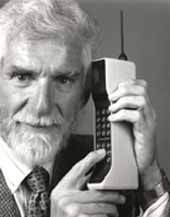
Much of a phone’s form factor is a result of the need for the device to, above all else, work as a phone. That is, it must be held against your face.
Of course, this is changing. The past few years have seen Bluetooth headsets spread from middle managers to nightclubs. In a few years, the idea of actually talking directly into your phone will be as archaic as a rotary dial. That’s not to say that phone devices will ever completely do away with built-in microphones and speakers (at least not in my lifetime), but they will eventually be little more than a backup for when your headset lands in the washer.
The point is: once the primary means of interfacing with your phone moves from the built-in speaker to some other method (Bluetooth or otherwise), designers will be liberated from the typical cell phone design, and will finally have the freedom to break through the mold of stale candybars, clamshells, and sliders.
As far as technical constraints go, we’re pretty much already to the point where we can pack a phone receiver into an incredibly small and thin package. The thinness race is pretty much over (sit down with anything skinnier than the Samsung Trace in your back pocket and you’ll likely hear a “snap”). The only thing really keeping phones as long and wide as they are is the concern for comfort and ergonomics — mere byproducts of the necessity of holding a phone in your hand against your face. Take this criteria away, and a whole slew of form factors become options.
Imagine a card-shaped phone no larger than a Visa that slides easily into your wallet. And for the ladies, how about a nice new bracelet phone (or just about any piece of jewelry)? The future lies in designs that do not impede your profile, weigh you down, or cause you to feel like you are carrying anything beyond your own body weight–that is, so-called “wearable” gadgets. Phones such as the iPhone are already trimming the number of physical buttons present on a phone to a bare mininum. The combination of “virtual” keys that change depending upon the situation and a super-thin OLED or e-ink-style display could create a functional device that requires an absolute bare minimum amount of display space.
Consumers are already getting sick of the same old designs (Note to mobile manufacturers: the fact that you keep pushing the same form factors is directly responsible for the diminished coverage cell phones are receiving in non-tech-oriented consumer lifestyle magazines—editors and art departments are simply sick of seeing the same rectangular box), and I’m assuming product designers are itching for the chance to bring their concept sketches to life. Hopefully soon, they’ll have the opportunity to.

Seth Porges writes on future technology and its role in personal electronics for his column, The Futurist. It appears every Thursday and an archive of past columns is available here.